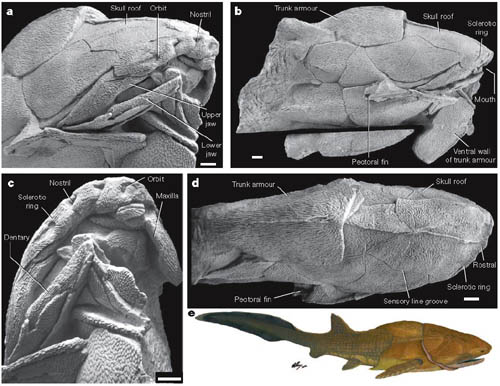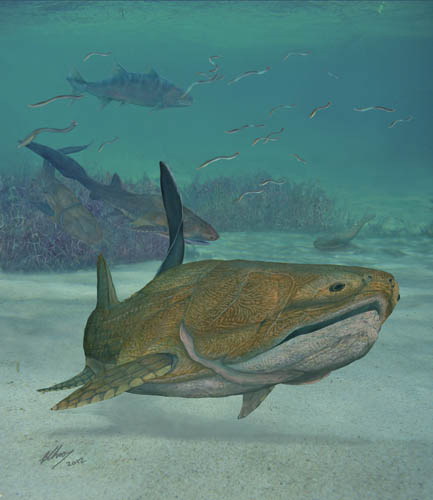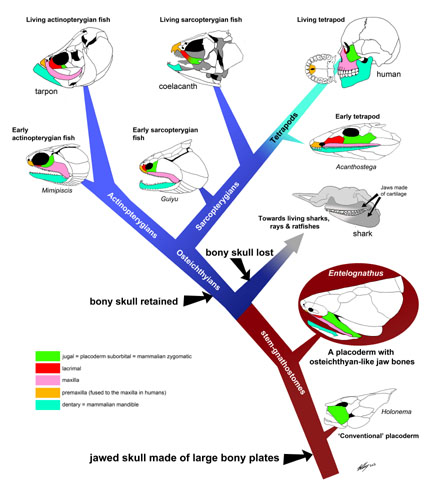| Location: Home > Research > Research Progress |
| Exceptionally-preserved Fossil Fish From China Reveals the Evolution of Early Jawed Vertebrates |
|
The evolution of jaws is one of the key episodes in the evolution of vertebrates, but the gap between jawed and jawless vertebrates is so large that it is hard to work out the individual evolutionary steps in the transition. An international team led by Dr. ZHU Min, Institute of Vertebrate Paleontology and Paleoanthropology (IVPP), Chinese Academy of Sciences, reported an exceptionally well-preserved 419-million-year-old fish from Qujing, Yunnan in China that is the most primitive vertebrate to have a modern type of jaw. This fish is a placoderm, one of a member of an extinct group of gnathostomes (jawed vertebrates), named Entelognathus primordialis, but its jaw is much more like that of a modern bony fish. The finding published online September 25 in Nature provides compelling evidence for the evolutionary link between placoderms and osteichthyans, and adjusts our understanding of early gnathostome evolution. The holotype of Entelognathus primordialis represents a three-dimensionally preserved fish with articulated head shield and trunk armour, approximately 11 cm long, suggesting a total body length of over 20 cm. It was unearthed from the Late Silurian (Late Ludlow, 419 million years ago) Kuanti Formation at the Xiaoxiang Reservoir near Qujing City of Yunnan Province in China. Entelognathus is a placoderm, an extinct grade of primitive armoured fishes. All other placoderms discovered up to this point have had simple jaws and cheeks, with the outer surfaces composed of only a few large bones. Entelognathus on the other hand has a more complex arrangement of smaller bones, including a premaxilla and maxilla lining the upper jaw and a dentary on the lower jaw plus cheek bones comprising a jugal and lacrimal. This is the same arrangement found in modern bone-bearing vertebrates including most fishes and all tetrapods, the limbed vertebrates including humans. Besides osteichthyans, the other living gnathostomes are the chondrichthyans, a group including sharks and rays. These have almost no bone in their bodies and have skeletons made of cartilage. Until very recently it was widely accepted that this condition represented the primitive state among the living jawed vertebrates. In other words, the most recent common ancestor of all gnathostomes would have looked something like a shark, devoid of armor and with a largely cartilaginous skull and skeleton. While both osteichthyans and placoderms have skulls made of large plates, it was widely assumed that the two groups were not related. Thus the immediate ancestors of osteichthyans would have acquired their bony skulls from scratch. It was even suggested that the jaws of placoderms evolved independently of other gnathostomes. This astounding discovery may offer a new perspective on the early evolution of these creatures. Osteichthyans did not independently acquire their bony skeletons, they simply inherited them from placoderm ancestors. At the same time, the lineage that led to chondrichthyans progressively lost their bony skeletons. Modern jawed vertebrates, such as sharks and bony fishes, emerge from a collection of jawed, armoured fishes known as placoderms. "The holotype specimen of Entelognathus was found in 2010, however a majority of the specimen was buried in the matrix in the field. Before its preparation in the laboratory, we had not paid special attention to this specimen", said Dr. ZHU Min of the IVPP, lead author and project designer, "The careful lab work in 2011 unveiled its superb preservation for a compelling evidence of an osteichthyan-like marginal jaw bones in a placoderm. If the jaws of Entelognathus were not articulated with the skull and trunk armour (as many specimens from the same horizon), we probably assign them to an osteichthyan fish". This work was mainly supported by the Major State Basic Research Projects of MST of China, and the National Natural Science Foundation of China.  Fig.1 Holotype of Entelognathus primordialis gen. et sp. nov., a 419-million-year-old jawed fish with head and trunk armour from the Kuanti Formation of Qujing, Yunnan, China, in anterolateral (a), lateral (b), anteroventral (c) and dorsal (d) views. Scale bars, 1 cm. e, Life restoration. (Image by ZHU Min)  Fig.2 Life restoration of Entelognathus primordialis. (Image by Brian Choo)  Fig.3 The progression of jawed vertebrate skull (Image by ZHU Min) |